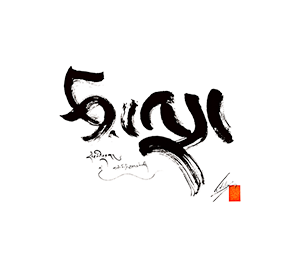Casey Kemp at the 2019 Tathāgatagarbha Symposium
From Buddha-Nature
< Media
Casey Kemp at the 2019 Tathāgatagarbha Symposium - 16 of 23
Video
Video
Description
Casey Kemp presents an overview and analysis of Jigten Gonpo’s explanation of luminosity as outlined in his text 'Od gsal rnam lnga gcig tu bsre ba'i man ngag, a pith instruction on merging (bsre ba).
Abstract from the Author
The Luminous Basis for Buddhahood: ’Jig rten mgon po’s Pith Instructions for Merging the Nature of Mind with the Dharmakāya
This paper will present an overview and analysis of 'Jig rten mgon po’s (1143–1217) explanation of luminosity (prabhāsvaratā; 'od gsal ba) from his Mahāmudrā perspective in terms of basis, path, and fruit. This is most clearly outlined in his 'Od gsal rnam lnga gcig tu bsre ba'i man ngag, a pith instruction on merging (bsre ba), a genre of Bka' brgyud teachings generally associated with the nā ro chos drug tradition. While chos drug instructions on luminosity tend to focus on deep sleep tantric practices, this text outlines luminosity in terms of mind’s true nature, which is to be pointed out, recognized, and ultimately merged with the dharmakāya. 'Jig rten mgon po offers a five-fold typology of luminosity: the luminosity of the basis, the path, dream, the bar do, and the ultimate. In this text, he explicitly explains that the luminosity of the basis is the nature of mind, described in terms of buddha-nature, and is none other than the dharmakāya itself. 'Jig rten mgon po goes on to explain the process of “merging” this basis with the path luminosity by way of pointing out instructions, which subsequently merges with the dream and bar do states naturally through direct recognition. Finally, this (collective) recognition of the basis is to be merged with the ultimate luminosity, the dharmakāya. 'Jig rten mgon po thus offers a framework for how the different types of tantric and non-tantric luminosity as understood in the early Bka' brgyud Mahāmudrā tradition can be merged by taking the nature of mind as both the basis for Buddhahood and ultimately inseparable from the fruit of the dharmakāya.
Sources Mentioned
Laṅkāvatārasūtra
An important Mahāyāna sūtra that was highly influential in East Asia as well as in Nepal, where a manuscript was discovered that remains the only extant Sanskrit recension of this text. It is notable for its inclusion of many doctrinal features that would come to be associated with the Yogācāra philosophy of Mind-Only (Cittamātra), such as the ālayavijñāna, or store-house consciousness, that acts as a repository for the seeds of karmic actions. It also includes several lengthy discussions of tathāgatagarbha and, though it is never actually referenced in the Uttaratantra, it is often listed among the so-called tathāgatagarbha sūtras. While its lack of mention in the Uttaratantra has been interpreted by scholars as evidence that the sūtra postdates the treatise, it should be noted that the ways in which the tathāgatagarbha is discussed in the sūtra is often at odds with its presentation in the Uttaratantra.
Laṅkāvatārasūtra;Gö Chödrub;འགོས་ཆོས་གྲུབ་;'gos chos grub;Facheng; Bodhiruci;Guṇabhadra;Śikṣānanda;'phags pa lang kar gshegs pa'i theg pa chen po'i mdo;འཕགས་པ་ལང་ཀར་གཤེགས་པའི་ཐེག་པ་ཆེན་པོའི་མདོ།;Laṅkāvatārasūtra;入楞伽經;लङ्कावतारसूत्र;འཕགས་པ་ལང་ཀར་གཤེགས་པའི་ཐེག་པ་ཆེན་པོའི་མདོ།
Maitreya, Asaṅga: Ratnagotravibhāga Mahāyānottaratantraśāstra
The Ratnagotravibhāga, commonly known as the Uttaratantra, or Gyu Lama in Tibetan, is one of the main Indian scriptural sources for buddha-nature theory. It was likely composed during the fifth century, by whom we do not know. Comprised of verses interspersed with prose commentary, it systematizes the buddha-nature teachings that were circulating in multiple sūtras such as the Tathāgatagarbhasūtra, the Mahāparinirvāṇasūtra, and the Śrīmaladevisūtra. The Tibetan tradition attributes the verses to the Bodhisattva Maitreya and the commentary to Asaṅga, and treats the two as separate texts, although this division is not attested to in surviving Indian versions. The Chinese tradition attributes the text to *Sāramati (娑囉末底), but the translation itself does not include the name of the author, and the matter remains unsettled. It was translated into Chinese in the early sixth century by Ratnamati and first translated into Tibetan by Atiśa, although this text is not known to survive. Ngok Loden Sherab translated it a second time based on teachings from the Kashmiri Pandita Sajjana, and theirs remains the standard translation. It has been translated into English several times, and recently into French. See the Ratnagotravibhāgavyākhyā, read more about the Ratnagotravibhāga, or take a look at the most complete English translation in When the Clouds Part by Karl Brunnholzl.
Ratnagotravibhāga Mahāyānottaratantraśāstra;byams chos sde lnga;Uttaratantra;Maitreya;བྱམས་པ་;byams pa;'phags pa byams pa;byams pa'i mgon po;mgon po byams pa;ma pham pa;འཕགས་པ་བྱམས་པ་;བྱམས་པའི་མགོན་པོ་;མགོན་པོ་བྱམས་པ་;མ་ཕམ་པ་;Ajita; Asaṅga;ཐོགས་མེད་;thogs med;slob dpon thogs med;སློབ་དཔོན་ཐོགས་མེད་;Āryāsaṅga;Sajjana;ས་ཛ་ན་;sa dza na;paN+Di ta sa dza na;sa dzdza na;པཎྜི་ཏ་ས་ཛ་ན་;ས་ཛཛ་ན་;Ngok Lotsāwa Loden Sherab;རྔོག་བློ་ལྡན་ཤེས་རབ་;rngog blo ldan shes rab;rngog lo tsA ba;lo chen blo ldan shes rab;blo ldan shes rab;རྔོག་ལོ་ཙཱ་བ་;ལོ་ཆེན་བློ་ལྡན་ཤེས་རབ་;Ngok Lotsāwa;Ngok Loden Sherab;Lochen Loden Sherab;Loden Sherab;Ratnamati;Rin chen blo gros;རིན་ཆེན་བློ་གྲོས;theg pa chen po rgyud bla ma'i bstan bcos;ཐེག་པ་ཆེན་པོ་རྒྱུད་བླ་མའི་བསྟན་བཅོས།;Ratnagotravibhāga Mahāyānottaratantraśāstra;究竟一乘寶性論;रत्नगोत्रविभाग महायानोत्तरतन्त्रशास्त्र;ཐེག་པ་ཆེན་པོ་རྒྱུད་བླ་མའི་བསྟན་བཅོས།
Secondary Publications Mentioned
People Mentioned
More on this recording
Related Texts
About the video
| Featuring | Casey Forgues Kemp |
|---|---|
| Creator | University of Vienna, Tsadra Foundation |
| Event | Tathāgatagarbha Across Asia (18 July 2019, University of Vienna, Austria) |
| Related Website | Buddha-Nature Project |
| Video Web Location | Tathāgatagarbha Across Asia |
| Creation Date | 18 July 2019 |
| Citation | Kemp, Casey. "The Luminous Basis for Buddhahood: ’Jig rten mgon po’s Pith Instructions for Merging the Nature of Mind with the Dharmakāya." Paper presented at the University of Vienna Symposium, Tathāgatagarbha Across Asia, Vienna, Austria, July 2019. Video, 41:36. https://www.youtube.com/watch?v=O7VQkhK1CE0. |
